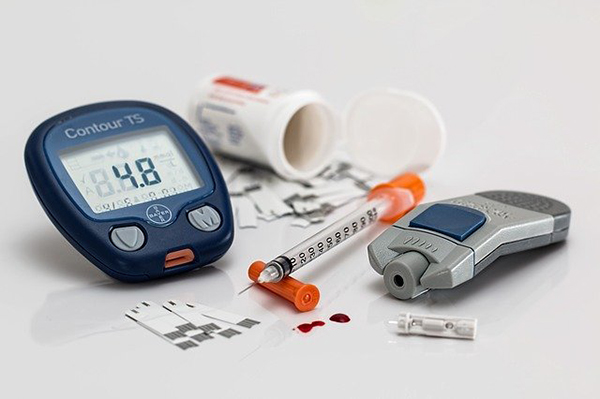Prediabetes and Children: What parents need to know
 November was American Diabetes Awareness Month. Now, more than ever, it is important to understand your family history, know your risk factors for certain diseases, and keep a healthy and active lifestyle. These are key elements to maintaining your family’s health – something that can be difficult for many this year.
November was American Diabetes Awareness Month. Now, more than ever, it is important to understand your family history, know your risk factors for certain diseases, and keep a healthy and active lifestyle. These are key elements to maintaining your family’s health – something that can be difficult for many this year.
Luckily, our knowledge of diabetes and prediabetes continues to increase, along with ways to minimize risk to ensure we stay healthy during this time of uncertainty. Understanding these factors is incredibly important, as one in five adolescents and one in four young adults currently live with prediabetes according to the CDC.
In an effort to raise awareness about prediabetes, Dr. Naik from PacMed’s Northgate location discusses prediabetes among children to help us better understand the topic and keep our loved ones healthy.
What is the difference between Type 1 Diabetes and Type 2 Diabetes?
Type 1 Diabetes commonly occurs during childhood and is caused by the body’s self-destruction of islet cells in the pancreas, leading to a lack of insulin production by the body. Alternatively, Type 2 Diabetes is commonly caused by insulin resistance in the body, eventually leading to decreased insulin production in later stages of the disease.What should parents know about diabetes and what are some key symptoms parents should be aware of?
Parents should know that diabetes can occur at any age. Common risk factors include:
- Obesity
- Family History
- Sedentary Lifestyles
- Cardiovascular Disease
- Chronic Steroid Use
- Genetic Predisposition
- Polycystic Ovary Syndrome (PCOS)
- Hypertension
- Elevated Cholesterol
Common symptoms of diabetes include:
- Increased Thirst
- Increased Urination
- Increased Hunger
- Changes in Vision
- Unintentional Weight Loss
- Frequent Infections
- Rashes
- Fatigue
- Ketones in Urine
- Non-Healing Sores
What is prediabetes?
Prediabetes is characterized by higher than normal glucose levels. It is incredibly important to monitor individuals with prediabetes, as prediabetes can lead to diabetes.
How does prediabetes affect kids and adults – is there any difference?
If prediabetes is not controlled with lifestyle changes, it can start affecting other organs in the body, such as our eyes, kidneys, and skin. Prediabetes and diabetes both also increase our risk of cardiovascular events.
Are there any preventative measures that families should be aware of as it relates to diabetes?
I recommend my patients stay hydrated, eat a diet rich in fiber and whole grains, exercise regularly, avoid fad diets, and keep weight under control to avoid getting prediabetes and diabetes.
What health-tech advancements have been made for diabetes patients?
Currently, the FDA has approved multiple continuous self-glucose monitoring systems that do not involve the use of needles or strips. Instead, you can get your reading with the swipe of a device, which can be checked 24/7. This method allows you to control the “highs and lows” of diabetes, leading to optimal control of one’s glucose levels.
Additionally, advances in the artificial pancreas is continuously underway. An artificial pancreas not only monitors glucose levels, but also delivers an optimal dose of insulin to the patient.
Is there anything else related to diabetes that you’d like readers to be aware of?
Prevention and early detection are key! If you have any of the risk factors or symptoms listed above, please reach out to your primary care physician to discuss the optimal age for routine screening and lifestyle changes. Our health is so important, and it is possible to control prediabetes if the necessary steps are taken.
Spotlight: A successful Wellness Symposium—and virtual, too!
The Living Well Alliance’s annual, one-of-a-kind wellness symposium for Puget Sound–area wellness coordinators was a booming success this past October. We thank our participants for their willingness to engage virtually, and for their thoughtful and creative contributions to our discussion. We hope our program is helping you to promote and grow your workplace wellness program.
Mint-Chocolate Meringue Cookies
This healthier, low-calorie cookie has some star ingredients such as protein-rich egg whites and antioxidant-loaded cocoa powder, and they’re easy to make. Enjoy during a festive video lunch or a special gathering within your household.
NUTRITION CORNER: 6 healthy holiday tips
As we approach a unique holiday season this year, taking care of your health continues to be important. Delicious, holiday foods bring us comfort and an opportunity to reimagine and invent traditions. Here are six reminders for health in the coming weeks.
- Focus on family and friends. With the pandemic and the holidays upon us, continue to put family and friends first. Instead of trying to re-create your normal extravagant meals for just a few people, try out some new recipes. Explore different traditions that you can share virtually. Social interaction can comfort us in similar ways to food by increasing our feel-good hormones. However, with social interaction, that emotional reward can last longer and be more satisfying.
- Experiment with cooking alternatives. Aim to reduce the amount of saturated fat and refined sugars you use for traditional recipes and incorporate healthy alternatives like natural sugars, fiber and unsaturated fats. For example, use olive oil instead of butter in a cake or casserole recipe. Or substitute natural sugars from fruits like apple or banana for added sugars in your favorite recipe. Try these other healthy-ingredient swaps.
- Eat slowly and savor every bite. Start every meal with gratitude about something you hold dear and, as you eat, appreciate the flavors of each bite. Eating slowly prevents overeating by allowing us to listen to our bodies’ hunger and fullness cues.
- Be mindful of portions. Take note of which items and how much of each is on your plate, especially in a meal with lots of food options. A good strategy for portion control is to mentally divide your plate:
- ¼ Select lean proteins such as poultry or fish to make up a quarter of the plate—or about the size of a deck of cards.
- ¼ Fuel up on complex carbohydrates such as whole-grain pastas, brown rice and vegetables like potatoes, corn, peas and squash. Portion these to fit in another quarter of the plate. Fiber from the complex carbs delays how fast blood glucose levels rise in the blood, which is especially important for those with type 2 diabetes.
- ½ Savor a variety of non-starchy vegetables such as dark green leafy vegetables, broccoli, carrots, cauliflower and celery. These should fill up to one half of your plate, are loaded with vitamins and fiber and don’t affect blood sugars as much.
Oregon Health and Science University offers this heart-healthy plate visual to help you visualize portions!
- Drink in moderation. Limit alcohol consumption to one drink per day for woman and two drinks per day for men. Focus instead on staying hydrated with these fun alternatives to water or a mocktail.
- Stay active. Continue any type of daily movement over the holidays to better your physical and mental health. Try an online yoga, Pilates or weights workout class, or check your local trail guide for winter-friendly hikes. See also the “Creative Winter Exercise” article in this newsletter.
Written by Christy Goff, MS, RDN, CD, and Diego Manjarrez, Bastyr dietetic intern during PacMed nutrition rotation.
Reimagine holidays and celebrations
If the holiday gatherings and family celebrations we cherish are disrupted, how will we handle the long, dark season ahead? As we all work together to slow and turn the outbreak of COVID-19, we may find some silver linings: More meaningful holidays. Deeper connections. More time to slow down and reflect.
PacMed therapist Eun Ku and the Living Well Alliance team share ideas for how a pandemic winter can be an opportunity to create the holidays we’ve always wanted—as well as birthdays and other missed gatherings.
Connect more deeply, outward
Reimagine the pandemic as an opportunity to avoid the “holiday rush” and instead connect with others. You might call Grandma on Sunday, spend time journaling on Wednesday and write a holiday letter on Saturday. You can also deliver gifts to friends’ doorsteps and say “hi!” from a distance.
With birthdays, a group video gathering might be a fun choice—but there are other options! Plan ahead and make a one-on-one date for virtual tea and conversation with a friend. Make sure you both have tea and cookies at the ready. A good, old-fashioned greeting card is a wonderful thing to receive in the mail, especially with a newsy letter, photo or loving note tucked inside.
Is a friend celebrating an anniversary? Choose a simple but fun menu, draw up a complete grocery list and share it with your friend’s household. Shop separately (no contact, pick-up groceries work well!), and then turn on Teams, Zoom or Facetime in your kitchen and cook together. A good screen and speakers are helpful. This works great with stir-frys and other fast meals. Have a glass of wine ready for when you sit down to dine together!
Connect more deeply, inward
Set side time for yourself. To manage the mental health impacts of isolation, choose healthy, self-soothing behaviors. You might try yoga, breathing exercises, contemplation, reading poetry aloud or meditation.
If you have experienced a loss from COVID, the slower and more contemplative pace of winter may open up new space to grieve. Use these quieter months to reflect on the past year, loved ones and the changes that have taken place. If the feelings that come up seem too powerful to handle on your own, it can help to work with a mental health professional to process them.
Get creative and stay active
If you love holiday outings, engage the family in a virtual trip-planning adventure. Research the places you want to travel to in the future, when safety allows. Or take a short drive to treat your brain to beautiful winter scenery or holiday lights—on homes or at a display like Stanwood’s Lights of Christmas. Another fun idea: Pretend you’re spending your holiday abroad and explore recipes from cuisines around the world.
It’s healthy to keep moving! If you enjoy decorations, add more ornaments or lights throughout the house. Change your front door decoration for New Year’s, the first day of snow, Valentine’s Day… Mix up your décor by painting a wall, rearranging furniture or putting up new artwork or photos. Take regular walks or search out some new spots for winter activities you love—like a hidden sledding hill or an open-air ice rink where you can maintain social distance.
You can learn more about therapist Eun Ku, LICSW, CMHS, EMMHS, and our other behavioral medicine providers at www.PacMed.org/BehavioralMedicine. All behavioral medicine visits are currently taking place via phone or virtual session. To schedule an appointment, please call 1.206.621.4045.
Diabetes: From diagnosis to successful self-care
Have a new diagnosis of diabetes? Or perhaps you recognize that your diabetes could be managed better? Self-care for diabetes can be overwhelming. It requires new knowledge, ongoing attention and a new mindset to keep moving forward.
So do you move from feeling stuck to finding success? How do you wrap your mind around this diagnosis?
Learn everything you can.
Your doctor and care team will guide your care and can point you to classes and support groups. A great resource to utilize first is the American Diabetes Association website.
Ask your care team to help you understand diabetes. Ask lots of questions! Here’s a brief introduction:
Insulin, a hormone in our bodies, keeps our blood glucose (sugars in the blood) at a healthy level. Diabetes is a condition where there is a lack of insulin or the insulin isn’t working well, and so, too much glucose collects in the blood. In Type 1 diabetes, the body cannot create insulin. Type 1 diabetes typically occurs earlier in life and is best managed by an endocrinologist. In Type 2 diabetes, the body develops a relative lack of or resistance to insulin. This usually occurs later in life and can be due to many things, including genetics and lifestyle factors.
Commit to success.
Diabetes is controlled with medications, by monitoring your blood sugars and by making lifestyle changes in diet, exercise and weight management.
It’s easier to be motivated when you understand the value of making lifestyle changes. These all play a role in keeping you healthy and your diabetes under control:
- Losing weight (decreasing excess body mass and fat cells) allows your body to regulate blood sugar more efficiently.
- Eating healthier and reducing your intake of carbohydrates and refined sugars decreases the amount of blood sugar the body must regulate.
- Increasing cardiovascular exercise burns calories and increases the body’s metabolism, empowering it to use up any excess sugar that might turn into fat tissue.
It’s not easy, but these lifestyle changes become more manageable and natural once you realize they will not only result in better blood sugar control, but also help prevent many other health conditions, leading to a healthier and happier you.
Partner with your primary care provider.
- Keep a log of what you eat and your activities. A daily log helps your doctor and diabetes educators to cater their advice to your particular situation. For example, if you tell your doctor that you eat pasta five times per week, he or she can make specific recommendations as to how much pasta or the type of pasta you should be eating.
- Ask about other care you might need. Your providers might suggest vaccines, annual eye and dental exams, foot care—all important for preventing and monitoring complications from diabetes.
- Know the danger signs of low blood sugar (hypoglycemia). Signs may include shaking, lightheadedness, nausea and sweating. Work with your doctor to create a plan for what you will do in this situation. Finally, make sure you understand the plan—don’t hesitate to say it’s not clear and ask questions!
PacMed encourages our patients to take an active role in their care by doing some research, being disciplined with their medications and lifestyle, and asking questions when needed.
You may learn more about PacMed diabetes care, nutrition classes and other resources at www.PacMed.org/Diabetes. To find a primary care provider to guide this care, visit Lynnwood providers at www.PacMed.org/Lynnwood
National Diabetes Awareness Month with Dr. Frias Garcia
Dr. Frias Garcia talks about Diabetes during the Coronavirus pandemic with Northwest Now.
The inspiring reason this Lynnwood doctor went into medicine
Dr. Rachel Pontemayor had a lot of doctor visits as a child. Diagnosed with a congenital heart murmur, she was fascinated by how her pediatrician treated her while explaining complex medical terms to her mother with ease, making her mother comfortable and confident with her child’s treatment.
Growing up in Guam, a United States island territory, Dr. Pontemayor’s access to routine healthcare specialists was limited, her pediatric cardiologist not continuously on the island. Her small island community also inspired her to pursue medicine, especially her grandmother, who had emigrated from the Philippines and settled in Guam to seek a new beginning for her family.
“Because of her I value education and family,” said Pontemayor, explaining her grandmother was illiterate. “My experiences drew me into medicine, and I wanted to learn more about it. For me, it’s about giving back to my grandmother and family for all the sacrifices they made, while being a trusted member of the community and giving back.”
“Because of her I value education and family,” says Dr. Pontemayor, explaining her grandmother was illiterate. “My experiences drew me into medicine, and I wanted to learn more about the field. For me, it’s about giving back to my grandmother and family for all the sacrifices they made, while being a trusted member of the community and giving back.”
While attending the Pacific Northwest University of Health Sciences in Yakima, Washington, the medical student, once set on pediatric practice, found a passion for the variety of patients and care found in family medicine. Plus, the geriatric patients reminded her of her grandmother.
“I like forming a relationship with a family and being able to follow it generation after generation,” emphasized Pontemayor.
To Dr. Pontemayor, being a physician is being someone her patients and their families can trust—someone who will be there to help them navigate the healthcare system. “I’m there to bridge the gap in their knowledge and my knowledge, to help them better take care of themselves and empower themselves,” she says.
Taking a holistic approach to medicine, Dr. Pontemayor attends to the minds, bodies and spirits of her patients. This method is yet another tool in her toolkit, allowing her to personalize her care, as so many varying factors affect a person’s health.
“They’re a whole person with all these different types of needs, and I feel like, in this regard, I’m better able to be an advocate for them and treat them from a whole-person perspective,” explains Dr. Pontemayor. “Everyone has different circumstances that affect who they are.”
Seeking a position in which she could provide high-quality care to families regardless of their socioeconomic background, Dr. Pontemayor chose to join Pacific Medical Centers (PacMed) in Lynnwood this September. Now, she’s getting to know and build relationships with not just her patients, but also their families.
Dr. Pontemayor is proud of PacMed’s reputation and the doctors’ team-based approach to serving patients, with specialists available when needed. “So far I’ve enjoyed it a lot; everyone’s been helpful, kind and team players,” she explains. “Everyone’s here to do what’s best for the patients.”
Dr. Pontemayor shares that serving the Lynnwood community is wonderful and that she enjoys how diverse and varied its population is.
For those crumbly goats
 Harvest Salad
Harvest Salad
Tip—prep squash and pecans a day ahead.
Comfort in a mug
 Soothing Golden Milk
Soothing Golden Milk
Pamper yourself with a mug of this warm, amber drink. Turmeric, a natural anti-inflammatory, is perfect after a vigorous walk, roll or climb.












